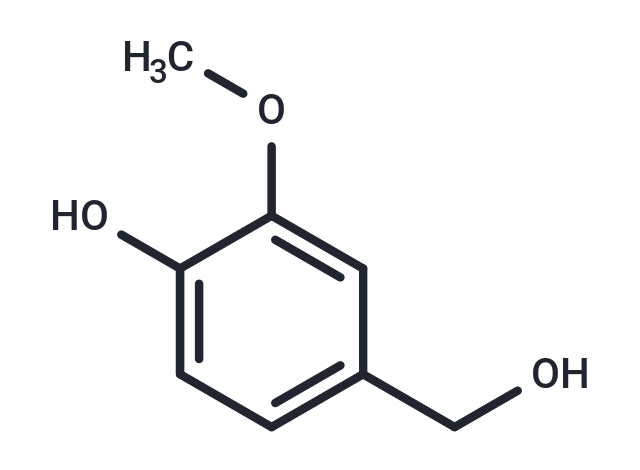Shopping Cart
Remove All Your shopping cart is currently empty
Your shopping cart is currently empty
Vanillyl Alcohol (3-Methoxy-4-hydroxybenzyl alcohol) possesses anti-angiogenic, anticonvulsive, anti-inflammatory, anti-oxidant, neuroprotective, and anti-nociceptive activities. Vanillyl alcohol can effectively inhibit the cytotoxicity and improved cell viability in 1-methyl-4-phenylpyridinium (MPP+)-induced MN9D dopaminergic cells, it also can attenuate the elevation of reactive oxygen species (ROS) levels, decrease in the Bax/Bcl-2 ratio and poly (ADP-ribose) polymerase proteolysis.

| Pack Size | Price | USA Warehouse | Global Warehouse | Quantity |
|---|---|---|---|---|
| 1 g | $29 | - | In Stock | |
| 1 mL x 10 mM (in DMSO) | $29 | In Stock | In Stock |
| Description | Vanillyl Alcohol (3-Methoxy-4-hydroxybenzyl alcohol) possesses anti-angiogenic, anticonvulsive, anti-inflammatory, anti-oxidant, neuroprotective, and anti-nociceptive activities. Vanillyl alcohol can effectively inhibit the cytotoxicity and improved cell viability in 1-methyl-4-phenylpyridinium (MPP+)-induced MN9D dopaminergic cells, it also can attenuate the elevation of reactive oxygen species (ROS) levels, decrease in the Bax/Bcl-2 ratio and poly (ADP-ribose) polymerase proteolysis. |
| Kinase Assay | For experiments with FAAH, rat liver homogenates, mouse brain homogenates and membranes from COS7 cells transfected with the human enzyme are used. Frozen (?80°C) livers from adult C57BL/6 mice and frozen brains (minus cerebella) from adult Wistar or Sprague-Dawley rats are thawed and homogenized in 20 mM HEPES, 1 mM MgCl2, pH 7. The homogenates are centrifuged at ~35000×g for 20 min at 4°C. After resuspension in buffer followed by recentrifugation and a second resuspension in buffer, the pellets are incubated at 37°C for 15 min. This incubation is undertaken in order to hydrolyse all endogenous FAAH substrates. The homogenates are then centrifuged as above, recentrifuged and resuspended in 50 mM Tris-HCl buffer, pH 7.4, containing 1 mM EDTA and 3 mM MgCl2. The homogenates are then frozen at ?80°C in aliquots until used for assay. FAAH is assayed in the homogenates and in the COS7 cell membranes using 0.5 μM (unless otherwise stated) [3H]AEA labelled in the ethanolamine part of the molecule. Blank values are obtained by the use of buffer rather than homogenate. In the experiments comparing effects of Biochanin A upon FAAH and FAAH-2, the same assay is used but with 16 nM [3H]oleoylethanolamide ([3H]OEA) as substrate and with an incubation phase at room temperature. The choice of OEA rather than AEA for FAAH-2 is motivated by the relative rates of hydrolysis: OEA is metabolized four times faster than AEA by FAAH-2, whereas for FAAH the rate of hydrolysis of OEA is about a third of that for AEA. When 0.5 μM [3H]AEA is used as substrate, assay conditions for rat brain and mouse liver are chosen so that <10% of added substrate is metabolized. For the human FAAH samples, <5% of the [3H]AEA is metabolized in all cases. For 16 nM [3H]OEA, a limited supply of an expensive ligand meant that optimization is not possible, and the amount of substrate utilized is higher (34±1 and 0.5±0.1% for FAAH and its corresponding mock-transfected, respectively; 40±2 and 21±0.4 for FAAH-2 and its corresponding mock-transfected respectively)[1]. |
| Synonyms | Vanillin alcohol, Vanillic alcohol, 4-Hydroxy-3-methoxybenzyl alcohol, 4-Hydroxy-3-methoxybenzenemethanol, 3-Methoxy-4-hydroxybenzyl alcohol |
| Molecular Weight | 154.16 |
| Formula | C8H10O3 |
| Cas No. | 498-00-0 |
| Smiles | O(C)C1=CC(CO)=CC=C1O |
| Relative Density. | 1.226 g/cm3 |
| Storage | Powder: -20°C for 3 years | In solvent: -80°C for 1 year | Shipping with blue ice/Shipping at ambient temperature. | |||||||||||||||||||||||||||||||||||
| Solubility Information | DMSO: 45 mg/mL (291.9 mM), Sonication is recommended. | |||||||||||||||||||||||||||||||||||
| In Vivo Formulation | 10% DMSO+40% PEG300+5% Tween 80+45% Saline: 2 mg/mL (12.97 mM), Sonication is recommended. Please add the solvents sequentially, clarifying the solution as much as possible before adding the next one. Dissolve by heating and/or sonication if necessary. Working solution is recommended to be prepared and used immediately. The formulation provided above is for reference purposes only. In vivo formulations may vary and should be modified based on specific experimental conditions. | |||||||||||||||||||||||||||||||||||
Solution Preparation Table | ||||||||||||||||||||||||||||||||||||
DMSO
| ||||||||||||||||||||||||||||||||||||
| Size | Quantity | Unit Price | Amount | Operation |
|---|

Copyright © 2015-2025 TargetMol Chemicals Inc. All Rights Reserved.